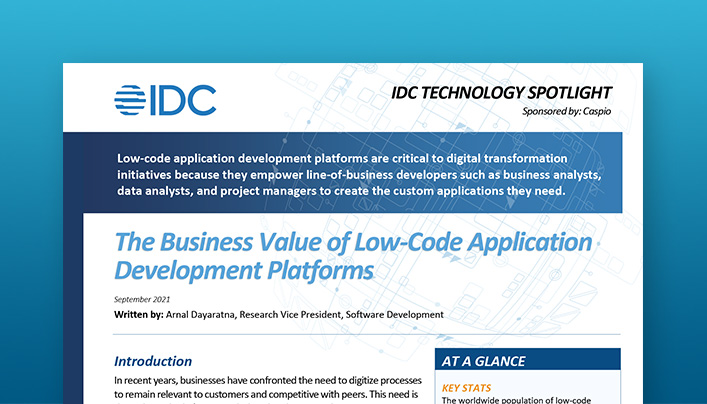Public Sector: Making a Difference One App at a Time
NO CODE 2018: Caspio for Education Nonprofit
My name is Cristina González Alcalá, and I’m with Summit Education Initiative.
Before I begin, I really want to give a round of applause to the Caspio team for putting a great conference together. They’ve been amazing. I’ve not yet been to a conference where the first person that I greet is like, “You’re Christina, right?” I’m like, “How do you know? We have never met. But yes, thanks.” I appreciate that personal touch.
So, let me talk to you about Summit Education Initiative. It’s a backbone organization in education in Summit County, which is located in Akron, Ohio. LeBron James, anyone? Yeah, that’s where we’re from.
Our mission is to improve personal and regional prosperity through increased educational attainment. And what does that mean, basically?
A Data-Driven Mission to Provide Strong Guidance
We want your kids, your family’s kids, and all the kids that we can control in Summit County, to be able to graduate high school and have a plan to be either employed, enrolled or enlisted. We want to give them that choice to have a career pathway, to make sure everybody is ready. And that actually starts from birth, even prenatal care, all the way to a career and beyond.
Yes, we are using a lot of data. And the work we do with it is predictive analytics.
So, we take that data, look at those students that have already graduated and have been successful, and go back all the way to kindergarten to see what they looked like in certain transition points like third grade, eighth grade, ninth grade, high-school and college graduation, and career persistence. We are able to pinpoint numerically, through stats, what those students did that made them successful. And yes, kindergarten is too late because you have to be prepared even in preschool.
A few of our apps have actually helped streamline those processes. And now that I’ve been here for three days, I know that there’s a term for that.
It’s called digital transformation, eliminating paper.
The Challenge of Being Overburdened With Data
What we faced here is the challenge of turning data into action to drive student success.
Bill was talking about what’s the difference between data and information, right? We take all that data and we try to create actionable information for our partners so that they have the tools to tailor their services to the students. With those efforts and hard work come a community alignment across the nation. It really is the work of the StriveTogether partnership.
What we see in this effort is the data overload of our partners.
They see the data. They’re asked for reports from funders who are like, “We need you to measure your outcomes. What does that look like? We need you to review your processes, how you’re serving the kids, and engage in this continuous improvement.” Which for a nonprofit — you know, Boys and Girls Club, a Boys Scouts’ Organization, a YMCA — they’re not worried about ensuring continuous improvement.
What they’re worried about is making sure they provide services to their kids so that they know how to read, so that they have a meal after school when a lot of them have no meals back home, so that they have a safe environment they can go to.
For them, data is the last thing that they want to look at. And if they do look at it, they are burdened by having to hire program evaluators.
Moving Toward Simplified, Secure Processes
We become that person that helps them out.
And the way we’ve done that is we’ve lessened some of those data requests that our partners give to public school districts, where somebody goes to the secretary and says, “I need these students’ test scores.” We don’t want that. The secretary is bugged by that. Why does a partner even need to go to school and ask for this information? We can make this process faster. And on top of that, once you start sharing data in Excel spreadsheets, confidential information is sent. No. I don’t want social security numbers. Why are you even sending them through email?
Just think about it for a second.
So, for us, it was important that we also found a FERPA-compliant tool. This secure access to education records has really been something that we have capitalized on. It is why we chose Caspio, also because you don’t need a coder. It is fast and it’s easy. You can create applications and look like a coder. We keep saying, “We’re not a programmer. We’re not a coder.” I just play one on TV and everybody believes me, and that’s cool. Thanks, Caspio.
It’s also WordPress-compatible.
I don’t know if you have a website technologies department, but we don’t because, again, we’re a nonprofit. We run with tight resources. We don’t have the ability to have somebody go and design web pages for us, so we turn to open-source methods like WordPress. But you guys are much better at this jargon than I am. Terms like APIs and CRMs go way over my head.
But the Caspio platform is indeed user-friendly. That’s why we wanted to use it and figure out what we can do.
Ensuring Compliance in Checking Student Data
One of the cool applications that I’ve done recently is called the Out-of-School Time Partner Portal.
So again, we’re working with organizations like the YMCA, the Girl Scouts, Big Brothers Big Sisters — and we’re ensuring a compliant path for them to be looking at student-level data. In the partnership that I talked about, there are about 50-plus organizations around the nation that look like us. And those organizations are still figuring out how to connect school data to their partners.
We have been able to do this. And not only connect them with almost real-time data due to near-daily uploads, but we’re also providing access at the student level. Which with FERPA, the Family Educational Rights and Privacy Act, you have to be very careful about doing.
So through the portal, and with a lot of the Caspio features, we’re able to lock down who can actually see that data. I’m actually allowing our partners to see up to 10 indicators right now. That’s anything from absences reports, discipline reports, GPAs and even kindergarten-readiness assessments. Yes, they get assessed when they get into kindergarten, and we’re able to show that data to our partners who are working with kindergartners.
Also, the main driver of this type of work was partners requiring students to bring in their report cards. It’s like, “Oh, you want to be part of our program? Well, we need to report to our funders, so we need to see what your report cards look like.” And they would require those report cards from the students and the families. And a lot of times you weren’t getting them.
So now, we provide for them a report that the funders have asked, which they can easily access in one spot.
From Data Overlead to Critical Student Insights
As I said, we want to convert data into information, right? We’re not just providing them the numbers to see and figure out, I’m also categorizing what that data looks like using formula fields.
Rather than just looking at the fact that Katie Bell missed one day of school in Marking Period 3, I am letting them know that Katie Bell is at low risk. And on the other hand, Roger Davis is on Marking Period 1. He already missed nine days of school. That kid is at high risk. You need to go talk to him and figure out why he’s missing class because he’s already falling behind, and it’s not even at the point where they have to test. They’re just not showing up for class.
It really has allowed the partners to start looking at the data and start understanding it. And here’s another — look at that report-card report. It just comes the same way they would see it.
So currently, we are reaching 25 organizations and we’re showing them 10 student-level academic indicators. I get happy. That equates to about 1,803 students from having zero students served through the portal in a matter of two years. It really has shown us that we are on the right path. A lot of the organizations that we partner with are trying to replicate this. And right now, they use things like Tableau, but it does not have record-level security and the ability to see personalized data, which is what Caspio has allowed us to do.
Caspio Saves Resources, Provides Quality Support
Moving forward, not backward, we want to start looking into interactive custom dashboards. This will allow our partners to start analyzing and acting on the data.
We can just start providing those services in a manner that’s easier for them. Rather than be bogged down by spreadsheets, all they have to do is log in and find all the data. And to actually print those charts, all they have to do is right-click, download as a PNG, slap it on their Word document, and there — they now have a standard report for the funders.
Using Caspio has actually, I believe, allowed the community to free up some resources from hiring a coder. Some organizations are actually involving universities that are heavy lifters in terms of data and programming capabilities.
Now, they’re using some of the money with us. But not enough, that it would burden down the funders. Those dollars are free to go to partners who directly serve the kids.
And before I end, this is the way I started using Caspio.
My boss was the one that said, “Here’s an application that I found. We’re going to start using this. Why don’t you go ahead and start learning it?” And that’s where my love affair began with Ned and Jason.
I just have to look at the videos and I was like, “Jason, what time are you getting there? It’s 8:00 over here and you’re still not in your office. I need you to call me as soon as you get to your office.” And sure enough, I think it was still 7:30, he’s like, “I’m okay, I’m just getting to my desk. But give me one second, I’ll log on and help you out.”
So, as we continue this partnership with Caspio, I really think we’re on a good course to continue providing applications to our partners that will save them money in the long run. It will also help the community outline those resources.
And now, every time somebody comes up to us with this problem and that problem — we just look at them and internally say, “We can Caspio that!”
Thank you.




